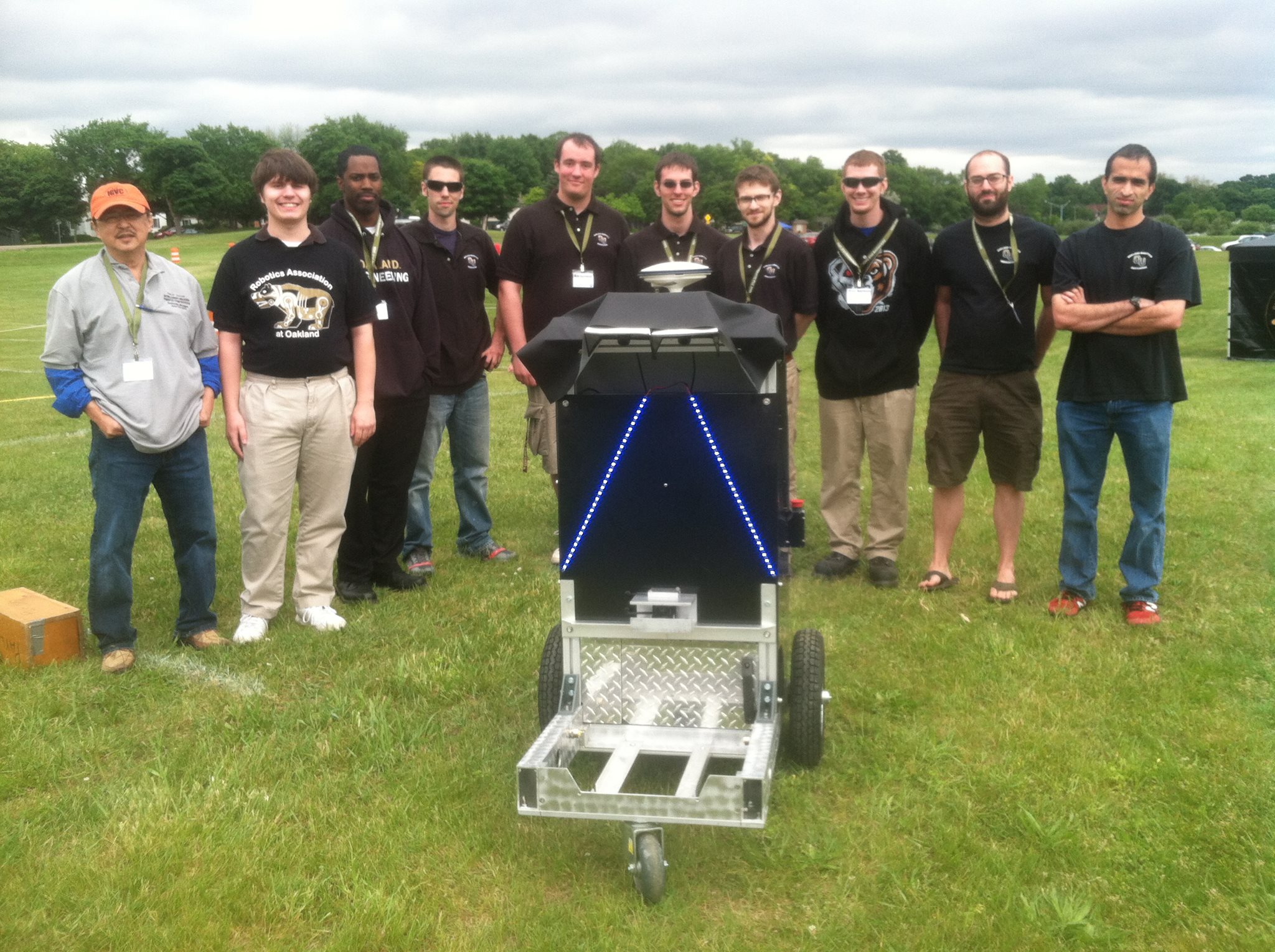
The team placed first overall this week, among 53 collegiate teams from across the globe, and brought the coveted Lescoe Cup home to Oakland University. The team’s placement was a first for ORA and OU.
IGVC challenges teams to compete autonomous robotic vehicles on an exterior course with defined lanes, GPS waypoints and random obstacles in an outdoor field environment. The four day event is held annually on Oakland University’s campus.
ORA also placed second in both the Design Competition and the Joint Architecture for Unmanned Systems (JAUS) Challenge, and third in the Autonomous Navigation Challenge.
“We at the School of Engineering and Computer Science are very proud and excited for our students and their adviser for winning first place at the 21st Annual Intelligent Ground Vehicle Competition,” Louay Chamra, Dean of the School of Engineering and Computer Science, said. “This accomplishment reflects commitment and hard work on the part of all of our SECS Robotic Team, and we celebrate this milestone with them and applaud them on their triumph.”
OU Electrical and Computer Engineering Professor KaC Cheok, Ph.D, is a co-chair and co-founder of IGVC and the ORA adviser.
“The OU robotics team is a multi-disciplinary group of engineering students whose talents peak simultaneously- mechanical, electrical, computer, mechatronics, and systems control engineering,” he said. “They are motivated, confident, knowledgeable, critical, creative, tireless and ambitious. And they get it done!’”
Micho Radovnikovich, ORA Adviser and systems engineering doctoral student, said the team spent about 600 hours developing and building their autonomous robotic vehicle, ‘Replicant’ at a cost of $14,000.
“My favorite part of this year’s IGVC was seeing our robot do exactly what we wanted it to do,” Radovnikovich said. “This is the most maneuverable robot that ORA has ever had at IGVC.”
Jerry Lane, co-founder, co-chair and chief judge of IGVC, said participating students are given a professional edge in the industry.
“We’re finding our graduates are starting companies, going into defense and going into the automotive industry,” said Lane, who is retired from TACOM/TARDEC. “IGVC takes students and makes them scientists and engineers and these students can be put to work, right away, without unnecessary training because they have the relevant experience, design skills and architectural skills from our competitions.”
Technologies utilized in the process are widely applicable and are quickly being commercialized – such as in the development of vehicles that drive and park autonomously, brake automatically and execute lane detection, among other features.
Bernard Theisen, co-chair and judge, said IGVC has sponsors in defense, as well as tier 1 and 2 automotive suppliers.
“IGVC is a good exercise and product realization that supports Science, Technology, Engineering, and Mathematics (STEM) and helps develop the robotics community in the United States,” said Theisen, a technical manager for the Autonomous Mobility Appliqué System at TARDEC.
“The automotive industry is moving in a huge concerted and competitive direction in active driver’s assistance systems (ADAS) where cars and trucks help to mitigate accidents,” Dr. Cheok said. “We are already seeing the robotics technologies incorporated in the automobiles today-- collision warning and avoidance systems, automatic parking (and more). You’d notice that Continental, Magna, Valeo and Takata, are sponsors of the IGVC.”
ORA students attribute their team’s success to their experiences within the School of Engineering and Computer Science.
Michael Truitt, an electrical and computer engineering graduate student, joined OU’s robotics team in 2010.
Unfavorable weather conditions did little to dampen the mood of the teams on the last day of the competition.
“Their spirit was contagious,” Lane said. “There was such a level of excitement being there, and watching the students, in the rain, just waiting to get their last turns in before the competition wrapped up-- it was phenomenal.”
Theisen said the weather gave students the opportunity to apply creative real-time solutions to their vehicles, such as waterproofing and adding traction.
The Lescoe Cup is named in memory of Paul Lescoe, an IGVC founder and lead robotic engineer at TARDEC.
The 22nd annual Intelligent Ground
Vehicle Competition will take place June 6-9, 2014 on the campus of
Oakland University. To learn more, visit igvc.org.
For a full list of schools that participated in the 2013 IGVC, click here.

Congratulations to the Oakland Robotics Association, who placed first this week at Intelligent Ground Vehicle Competition. Pictured here with "Replicant" is Prof. KaC Cheok, Parker Bidigare, Matthew Franklin, Mike Truitt, Micho Radovnikovich, Kevin Hallenbeck, Steve Grzebyk, Mike Norman, Lincoln Lorenz and Kiran Iyengar.